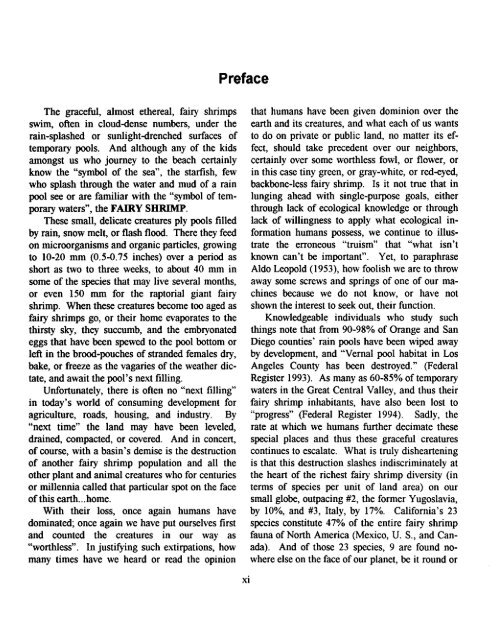Fairy Shrimps
Fairy Shrimps
Fairy Shrimps
Create successful ePaper yourself
Turn your PDF publications into a flip-book with our unique Google optimized e-Paper software.
Preface<br />
The graceful, almost ethereal, fairy shrimps<br />
swim, often in cloud-dense numbers, under the<br />
rain-splashed or sunlight-drenched surfaces of<br />
temporary pools. And although any of the kids<br />
amongst us who journey to the beach certainly<br />
know the "symbol of the sea", the starfish, few<br />
who splash through the water and mud of a rain<br />
pool see or are familiar with the "symbol of temporary<br />
waters", the FAIRY SHRIMP.<br />
These small, delicate creatures ply pools filled<br />
by rain, snow melt, or flash flood. There they feed<br />
on microorganisms and organic particles, growing<br />
to 10-20 mm (0.5-0.75 inches) over a period as<br />
short as two to three weeks, to about 40 mm in<br />
some of the species that may live several months,<br />
or even 150 mm for the raptorial giant fairy<br />
shrimp. When these creatures become too aged as<br />
fairy shrimps go, or their home evaporates to the<br />
thirsty sky, they succumb, and the embryonated<br />
eggs that have been spewed to the pool bottom or<br />
left in the brood-pouches of stranded females dry,<br />
bake, or freeze as the vagaries of the weather dictate,<br />
and await the pool's next filling.<br />
Unfortunately, there is often no "next filling"<br />
in today's world of consuming development for<br />
agriculture, roads, housing, and industry. By<br />
"next time" the land may have been leveled,<br />
drained, compacted, or covered. And in concert,<br />
of course, with a basin's demise is the destruction<br />
of another fairy shrimp population and all the<br />
other plant and animal creatures who for centuries<br />
or millennia called that particular spot on the face<br />
of this earth... home.<br />
With their loss, once again humans have<br />
dominated; once again we have put ourselves first<br />
and counted the creatures in our way as<br />
"worthless". In justifying such extirpations, how<br />
many times have we heard or read the opinion<br />
that humans have been given dominion over the<br />
earth and its creatures, and what each of us wants<br />
to do on private or public land, no matter its effect,<br />
should take precedent over our neighbors,<br />
certainly over some worthless fowl, or flower, or<br />
in this case tiny green, or gray-white, or red-eyed,<br />
backbone-less fairy shrimp. Is it not true that in<br />
lunging ahead with single-purpose goals, either<br />
through lack of ecological knowledge or through<br />
lack of willingness to apply what ecological information<br />
humans possess, we continue to illustrate<br />
the erroneous "truism" that "what isn't<br />
known can't be important". Yet, to paraphrase<br />
Aldo Leopold (1953), how foolish we are to throw<br />
away some screws and springs of one of our machines<br />
because we do not know, or have not<br />
shown the interest to seek out, their function.<br />
Knowledgeable individuals who study such<br />
things note that from 90-98% of Orange and San<br />
Diego counties' rain pools have been wiped away<br />
by development, and "Vernal pool habitat in Los<br />
Angeles County has been destroyed." (Federal<br />
Register 1993). As many as 60-85% of temporary<br />
waters in the Great Central Valley, and thus their<br />
fairy shrimp inhabitants, have also been lost to<br />
"progress" (Federal Register 1994). Sadly, the<br />
rate at which we humans further decimate these<br />
special places and thus these graceful creatures<br />
continues to escalate. What is truly disheartening<br />
is that this destruction slashes indiscriminately at<br />
the heart of the richest fairy shrimp diversity (in<br />
terms of species per unit of land area) on our<br />
small globe, outpacing #2, the former Yugoslavia,<br />
by 10%, and #3, Italy, by 17%. California's 23<br />
species constitute 47% of the entire fairy shrimp<br />
fauna of North America (Mexico, U. S., and Canada).<br />
And of those 23 species, 9 are found nowhere<br />
else on the face of our planet, be it round or<br />
xi
















